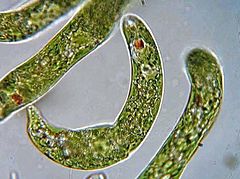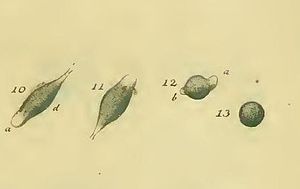- Euglena
-
Euglena 
Scientific classification Domain: Eukaryota Kingdom: Protista Superphylum: Discoba Phylum: Euglenozoa Class: Euglenoidea Order: Euglenales Family: Euglenaceae Genus: Euglena
Ehrenberg, 1830Euglena is a genus of unicellular flagellate protists. It is the best known and most widely studied member of the phylum Euglenozoa (also known as Euglenophyta), a diverse group containing some 44 genera and at least 800 species.[1] Species of Euglena are found in fresh and salt waters. They are often abundant in quiet, inland waters, where they may bloom in numbers sufficient to color the surface of ponds and ditches green (E. viridis) or red (E. sanguinea). [1]
The species Euglena gracilis, has been used extensively in the laboratory as a model organism.[2]
Most species of Euglena have photosynthesizing chloroplasts within the body of the cell, which enable them to feed by autotrophy, like plants. However, they can also take nourishment heterotrophically, like animals. Since Euglena have features of both animals and plants, early taxonomists, working within the Linnaean two-kingdom system of biological classification, found it a difficult organism to classify. [3] [4] Indeed, it was the question of where to put such "unclassifiable" creatures that prompted Ernst Haeckel to add a third kingdom to the Animale and Vegetabile of Linnaeus: the Kingdom Protista.[5]
Contents
Form and function
When feeding as a heterotroph, the Euglena surrounds a particle of food and consumes it by phagocytosis. When there is sufficient sunlight for it to feed by phototrophy, it uses chloroplasts containing the pigments Chlorophyll a and Chlorophyll b to produce sugars by photosynthesis. [6] Euglena's chloroplasts are surrounded by three membranes, while those of plants and the green algae (among which earlier taxonomists often placed Euglena) have only two membranes. This fact has been taken as morphological evidence that Euglena's chloroplasts evolved from a eukaryotic green algae.[7] Thus, the intriguing similarities between Euglena and the plants would have arisen, not because of kinship, but because of a secondary endosymbiosis. Molecular phylogenetic analysis has lent support to this hypothesis, and it is now generally accepted.[8] [9]
Euglena chloroplasts contain pyrenoids, used in the synthesis of paramylon, a form of starch energy storage enabling Euglena to survive periods of light deprivation. The presence of pyrenoids is used as an identifying feature of the genus, separating it from other Euglenoids, such as Lepocinclis and Phacus. [10]
Like other Euglenoids, Euglena possess a red eyespot, an organelle composed of carotenoid pigment granules. The red spot itself is not thought to be photosensitive. Rather, it filters the sunlight that falls on a light-detecting structure at the base of the flagellum (a swelling, known as the paraflagellar body), allowing only certain wavelengths of light to reach it. As the cell rotates with respect to the light source, the eyespot partially blocks the source, permitting the Euglena to find the light and and move toward it (a process known as phototaxis).[11]
Euglena lacks a cell wall (an outer membrane containing cellulose). Instead, it has a pellicle made up of a protein layer supported by a substructure of microtubules, arranged in strips spiraling around the cell. The action of these pellicle strips sliding over one another gives Euglena its exceptional flexibility and contractility.[11]
In low moisture conditions, or when food is scarce, Euglena forms a protective wall around itself and lies dormant as a resting cyst until environmental conditions improve.
Historical background and early classification
Species of Euglena were among the first protists to be seen under the microscope.
In 1674, in a letter to the Royal Society, the Dutch pioneer of microscopy Antony van Leeuwenhoek wrote that he had collected water samples from an inland lake, in which he found "animalcules" that were "green in the middle, and before and behind white." Clifford Dobell regards it as "almost certain" that these were Euglena viridis, whose "peculiar arrangement of chromatophores...gives the flagellate this appearance at low magnification."[12]
Twenty-two years later, John Harris published a brief series of "Microscopical Observations" reporting that he had examined "a small Drop of the Green Surface of some Puddle-Water" and found it to be "altogether composed of Animals of several Shapes and Magnitudes." Among them, were "oval creatures whose middle part was of a Grass Green, but each end Clear and Transparent," which "would contract and dilate themselves, tumble over and over many times together, and then shoot away like Fishes." [13]
In 1786, O.F. Müller gave a more complete description of the organism, which he named Cercaria viridis, noting its distinctive color and changeable body shape. Müller also provided a series of illustrations, accurately depicting the undulating, contractile movements (or metaboly) of Euglena's body.[14]
In 1830, C. G. Ehrenberg renamed Müller's Cercaria Euglena viridis, and placed it, in keeping with the short-lived system of classification he invented, among the Polygastrica in the family Astasiaea: multi-stomached creatures with no alimentary canal, variable body shape but no pseudopods or lorica [15] [16]. By making use of the newly-invented achromatic microscope (Notes and Queries, vol 12(13): 459), Ehrenberg was able to see Euglena's eyespot, which he correctly identified as a "rudimentary eye" (although he reasoned, wrongly, that this meant the creature also had a nervous system).
Ehrenberg did not notice Euglena's flagella, however. The first to publish a record of this feature was Félix Dujardin, who added "filament flagelliforme" to the descriptive criteria of the genus in 1841. [17] Subsequently, the class Flagellata (Cohn, 1853) was created for creatures, like Euglena, possessing one or more flagella. While "Flagellata" has fallen from use as a taxon, the notion of using flagella as a phylogenetic criterion remains vigorous. [18]
Recent Phylogeny and Classification
In 1881, Georg Klebs made a primary taxonomical distinction between green and colorless flagellate organisms, separating the photosynthesizing Euglenoids from those that live by phagotrophy. The latter (colorless, shape-changing uniflagellates) were divided among the Astasiaceae and the Peranemaceae, while flexible green Euglenoids were generally assigned to the genus Euglena. [19]
As early as 1935, it was recognized that this was an artificial grouping, however convenient.[20]. In 1948, Pringsheim affirmed that the distinction between green and colorless flagellates had no taxonomical justification, although he acknowledged its practical appeal. He proposed something of a compromise, placing colorless, saprotrophic Euglenoids in the genus Astasia, while allowing some colorless Euglenoids to share a genus with their photosynthesizing cousins, provided they had structural features that proved common ancestry. Among the green Euglenoids themselves, Pringsheim recognized the close kinship of some species of Phacus and Lepocinclis with some species of Euglena.[19]
The idea of classifiying the Euglenoids by their manner of nourishment was finally abandoned in the 1950s, when A. Hollande published a major revision of the phylum, grouping organisms by shared structural features, such as the number and type of flagella.[21] If any doubt remained, it was dispelled in 1994, when genetic analysis of the non-photosynthesizing Euglenoid Astasia longa confirmed that this organism retains sequences of DNA inherited from an ancestor that must have had functioning chloroplasts.[22]
In 1997, a morphological and molecular study of the Euglenozoa, put Euglena gracilis in close kinship with the species Khawkinea quartana, with Peranema trichophorum basal to both.[23] Two years later, a molecular analysis showed that Euglena gracilis was, in fact, more closely related to Astasia longa than to certain other species recognized as Euglena. Furthermore, the venerable Euglena viridis was found to be genetically closer to Khawkinea quartana than to the other species of Euglena studied.[21]
Recognizing the polyphyletic nature of the genus Euglena, Marin et al. (2003) have revised it to include certain members traditionally placed in Astasia and Khawkinea.[10]
Image Gallery
Video Gallery
Various Euglenoids Euglena spyrogyra
Euglena spyrogyra Euglena sanguinea
Euglena sanguinea Lepocinclis oxyuris and Euglena gigas
Lepocinclis oxyuris and Euglena gigas
References
- ^ a b Wolosski, Konrad. "Phylum Euglenophyta" in The Freshwater Algal Flora of the British Isles: an Identification Guide to Freshwater and Terrestrial Algae. John, DM et al. eds. ISBN 978-0521770514 . p. 144
- ^ Russell et al. 2005. Unusual features of fibrillarin cDNA and gene structure in Euglena gracilis: evolutionary conservation of core proteins and structural predictions for methylation-guide box C/D snoRNPs throughout the domain Eucarya. Nucleic Acids Research. 33(9):2781-91
- ^ Margulis, Lynn, and Sagan, Dorion. Dazzle Gradually. Chelsea Green: White River Junction, 2007. p. 30 ISBN 1933392312
- ^ Keeble, Plant-Animals Cambridge University Press: London, 1912. pp. 103-4.
- ^ Solomon, Eldra Pearl et al. Biology. Brooks/Cole Thompson Learning: Belmont, 2004. p. 421. ISBN 0-534-49276-2
- ^ Nisbet, Brenda. Nutrition and Feeding Strategies in Protozoa. 1984. ISBN 0-7099-1800-3 p. 73
- ^ Gibbs, Sarah P. The Chloroplasts of Euglena may have Evolved from Symbiotic Green Algae. Can J Bot 56:2883–2889 DOI 10.1139/b78-345
- ^ Henze, et al. 1995. A nuclear gene of eubacterial origin in Euglena gracilis reflects cryptic endosymbioses during Protist evolution. Proc. Natl. Acad. Sci. USA. Vol 92:9122-9126
- ^ Nudelman, 2003. Phylogeny of Euglenophyceae based on small subunit rDNA sequences: Taxonomic Implications. J. Phycol. 39:226-235.
- ^ a b Marin et al. 2003. Phylogeny and taxonomic Revision of Plastid-containing Euglenophytes Based on SSU rDNA Sequence Comparisons and Synapomorphic Signatures in the SSU rRNA Secondary Structure. Protist. 154(1):99-145.
- ^ a b Schaechter, Moselio. Eukaryotic Microbes. Elsevier/Academic Press: San Diego, 2011. ISBN 978-0-12-383876-6 . p. 315.
- ^ Dobell, Clifford. Antony van Leeuwenhoek and his "Little Animals". New York: Dover, 1932, 1960. 111. ISBN 0486605949
- ^ Harris, John. Some Microscopical Observations of Vast Numbers of Animalcula Seen in Water. Philosophical Transactions (1683-1775), Vol. 19 (1695 - 1697). 254-259.
- ^ Müller, O.F. Animalcula Infusoria, Fluvia Tilia et Marina. 1786. Hauniae, Typis N. Mölleri. pp. 126,473.
- ^ Ehrenberg, C. Organisation, Systematik und geographisches Verhältnifs der Infusionsthierchen. Vol. II. Berlin, 1830. pp 58-9
- ^ Pritchard, Andrew. A History of Infusoria, Living and Fossil: arranged according to "Die Infusionsthierchen" of C. G. Ehrenberg. Whittaker: London, 1845. p. 86.
- ^ Dujardin, F. Histoire Naturelle des Zoophytes. Infusoires, comprenant la Physiologie et la Classification de ces Animaux, et la Manière de les Étudier a l'aide du Microscope. Paris, 1841. p. 358
- ^ Cavalier-Smith, Thomas. October 2003. Phylogeny and Classification of Phylum Cercozoa (Protozoa). Protist 154:341-358.
- ^ a b Pringsheim, E.G. Taxonomic Problems in the Euglenineae. Biological Reviews 23(1):46-61. DOI: 10.1111/j.1469-185X.1948.tb00456.x
- ^ Fritsch, F. E. The Structure and Reproduction of the Algae. Cambridge UP. Cambridge, 1935. p. 741
- ^ a b Linton et al. 1999. A Molecular Study of Euglenoid Phylogeny using Small Subunit rRNA. J. Euk. Microbiol. 46(2):217-223.
- ^ Gockel et al. 1994. Genes for components of the chloroplast translational apparatus are conserved in the reduced 73-kb plastid DNA of the nonphotosynthetic euglenoid flagellate Astasia longa. Current Genetics. 26 (3):256-262. DOI: 10.1007/BF00309557
- ^ Montegut-Felkner. 1997. Phylogenetic Relationships of Selected Euglenoid Genera, based on Morphological and Molecular Data. Jurnal of Phycology. 33:512-519. DOI: 10.1111/j.0022-3646.1997.00512.x
External links
- The Euglenoid Project
- Tree of Life web project: Euglenida
- Protist Images: Euglena
- Euglena at Droplet - Microscopy of the Protozoa
- Images and taxonomy
- Effect of Light Intensity on the Lipid Composition of Euglena gracilis
Eukaryota Bikonta AH/SARAHSARHalvariaHeterokont ("S")Unikonta Apusomonadida (Apusomonas, Amastigomonas) · Ancyromonadida (Ancyromonas) · Hemimastigida (Hemimastix, Spironema, Stereonema)HolozoaFilozoaFilastereaChoanoflagellateaExcavata Discoba Schizopyrenida: Vahlkampfiidae (Naegleria, Neovahlkampfia, Paravahlkampfia, Psalteriomonas, Sawyeria, Tetramitus/Paratetramitus, Vahlkampfia, Willaertia) · Gruberellidae (Stachyamoeba) · Rosculus
Acrasidae (Acrasis)
Heteramoeba · Learamoeba · Monopylocystis · StygamoebaPercolateaAndaluciidaAndaluciaJakobidaM+M TrichozoaFornicataEopharingiaDiplomonadida: Hexamitinae (Spironucleus, Hexamita) · Giardiinae (Giardia, Octomitus)
Retortamonadida (Chilomastix, Retortamonas)OtherCarpediemonadida (Carpediemonas) · DysnectesAnaeromonadeaOtherCategories:- Euglenozoa
- Protist genera
Wikimedia Foundation. 2010.






